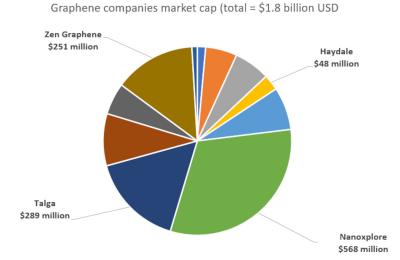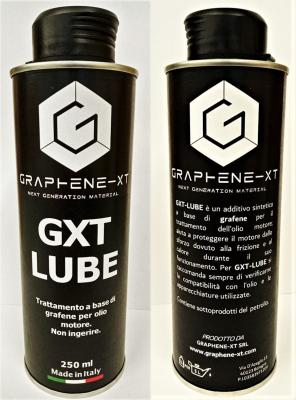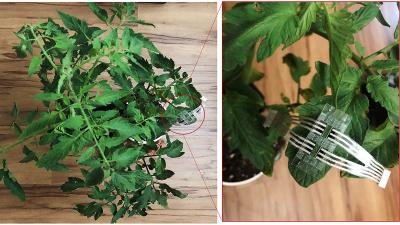The Graphene-Info weekly newsletter
Published: Tue, 07/13/21
The Graphene-Info newsletter (July 13, 2021)
Cannot read this? View it online here
Public graphene companies reach almost $2 billion in market value
The graphene industry seems to be flourishing, at least when looking at the valuations of public companies. As we reported earlier this year, graphene stocks have risen nicely towards the end of 2020, and the trend continues in 2021 for most companies.

The total market value of graphene companies now reaches $1.8 billion USD for the 13 leading graphene public companies we track. It is important to note that not all this value is directly related to graphene - some of the companies have other activities, mainly graphite mining and supply. But for all these companies, graphene is a major part of the business, and most of the companies are pure-play graphene companies.
Graphene-XT develops graphene-enhanced lubricating oil additive for engines
Researchers at Graphene-XT have developed a new graphene-based lubricating oil additive for diesel and petrol engines in cars or motorcycles.

By introducing graphene into a lubricating oil, Graphene-XT found that both its performance and stability improved, resulting in more compression and less wear and tear in the engine parts of both cars and motorcycles.
New graphene-based coating developed for the protection of paintings
A team of researchers from the Institute of Chemical Engineering Sciences of Foundation for Research and Technology-Hellas (FORTH/ ICE-HT), the Department of Chemical Engineering of the University of Patras, and the Center for Colloid and Surface Science (CSGI) of the University of Florence, led by Professor Costas Galiotis, set out to use 'graphene veils' for the protection of paintings against environmental degradation.
The exposure of colors used in artworks to ultraviolet (UV) and visible light in the presence of oxidizing agents, triggers color degradation, fading and yellowing. These degradation mechanisms can lead to irreversible alteration of artworks, which consist of a valuable heritage for humankind. Currently used protective varnishes and coatings are often problematic, as their removal requires the use of solvents, which can adversely affect the underlying work surface.
Merck and Inbrain Neuroelectronics collaborate on graphene-based bioelectronic therapy technology
Major pharma company Merck has announced a collaboration agreement with Innervia Bioelectronics, a start-up and subsidiary of Inbrain Neuroelectronics S.L., Barcelona, Spain. The aim of the collaboration is to co-develop the next generation of graphene-based bioelectronic vagus nerve therapies targeting severe chronic diseases within the therapeutic areas addressed by Merck.
“We aim to accelerate developments in the emerging field of bioelectronics by boosting the novel modality of selective neurostimulation,” said Laura Matz, Chief Science and Technology Officer of Merck. “Today’s agreement with Innervia Bioelectronics gives Merck access to a unique technology that increases energy efficiency in neurostimulators and could therefore become a true enabler for digital personalized treatment of patients suffering from severe and chronic diseases such as inflammatory disorders.”
Lithium Energy to pursue commercial lithium-ion battery opportunities for its graphene
Lithium Energy, an emerging battery minerals company with two exploration and development projects (the Solaroz Lithium Project in Argentina and the Burke Graphite Project in Queensland), has announced its plans to pursue commercial opportunities for using its graphene in lithium-ion batteries
Testing by the Company has reportedly confirmed its Burke Deposit is well suited for graphene production via electrochemical exfoliation process, via a relatively low cost and environmentally friendly process that produces very high purity graphene products.
Researchers use twisted graphene multilayers to unlock radiation-free quantum technology
Rare-earth compounds have attracted researchers for decades thanks to the unique quantum properties they display, which have so far remained out of reach of everyday compounds. One of the most remarkable and exotic properties of those materials is the emergence of exotic superconducting states, and particularly the superconducting states required to build future topological quantum computers. While these specific rare-earth compounds, known as heavy fermion superconductors, have been known for decades, making usable quantum technologies out of them has remained a challenge because they contain critically radioactive compounds, such as uranium and plutonium, rendering them of limited use in real-world quantum technologies.
In a recent study, researchers from Aalto University and Paul Scherrer Institute have found a way to achieve 'heavy fermions' in subtly modified graphene - a cheaper and safer alternative to the rare-earth compounds in which it was possible until now. The researchers showed in their paper how the quantum state known as a “heavy fermion” can be produced by combining three twisted graphene layers. A heavy fermion is a particle – in this case an electron – that behaves like it has a lot more mass than it actually does. The reason it behaves this way stems from unique quantum many-body effects that were mostly only observed in rare-earth compounds until now. This heavy fermion behavior is known to be the driving force of the phenomena required to use these materials for topological quantum computing. This new result demonstrates a new, non-radioactive way of achieving this effect using only carbon, opening up a pathway for sustainably exploiting heavy fermion physics in quantum technologies.
Frontier IP provides funding to graphene-based photonics developer CamGraPhIC
Frontier IP Group subscribed to £842,810 of loan notes from portfolio company CamGraPhIC as part of a £1.5 million loan designed to help accelerate growth of CamGraPhIC, spun out of the University of Cambridge to develop graphene-based photonics for high-speed data and telecommunications.
CamGraphIC says it is currently working with partners to fabricate proof-of-concept sample devices.
Graphene-based plant patches enable continuous monitoring for crop diseases
Researchers from North Carolina State University have developed graphene-based patches that plants can “wear” to monitor continuously for plant diseases or other stresses, such as crop damage or extreme heat.

“We’ve created a wearable sensor that monitors plant stress and disease in a noninvasive way by measuring the volatile organic compounds (VOCs) emitted by plants,” says Qingshan Wei, co-corresponding author of a paper on the work and an assistant professor of chemical and biomolecular engineering at NC State.
Asbury Carbons acquires Garmor
Asbury Carbons, processor of carbon and graphite materials, recently announced that it has acquired Garmor, an advanced materials company based in Orlando, Florida with a patented, environmentally friendly process for the commercial production of Edge Functionalized Graphene (EFG).
In line with its strategy of growth through diversification, the acquisition of Garmor is meant to enhance Asbury’s portfolio of engineered material solutions for adhesives, asphalt, cement, coatings, as well as plastic and metal-matrix composites.
Skeleton Technologies raises €29 Million in Series D extension
Skeleton Technologies recently announced the closing of a further €29 Million in its Series D round of funding. With this development, the total funding in Round D now amounts to €70.4 Million – including the €41.3 Million announced in November 2020.
This round follows the company’s €51 Milion funding by Germany’s Federal Ministry for Economic Affairs and Energy (BMWi) and the Free State of Saxony, announced in March 2021.
Haydale and ProMake sign collaboration agreement
Haydale has announced that further to a memorandum of understanding signed on 11 November 2020, it has now signed a Collaboration Agreement with ProMake Limited with respect to the fulfilment of Promake's commitments under the Public Health England ("PHE") National Microbiology Framework.
In line with the UK Government's aim to supply fast turnaround tests in its fight against Covid-19, PHE announced a new National Microbiology Framework in November 2020. There were four discrete lots within this framework and ProMake tendered for Lot 2 and Lot 4.
Skeleton Technologies enters agreement with CAF Power & Automation for supercapacitors for trams
Skeleton Technologies has signed a contract with CAF Power & Automation, a global manufacturer of electric power solutions for the rail industry, to supply supercapacitors in trams powered by CAF P&A’s OESS-s (On Board Energy Storage Systems).

Skeleton’s cells will reportedly be included in Greentech OESS portfolio already used by some of the leading railway companies worldwide to offer cutting edge solutions to energy recovery, peak shaving and catenary-free applications.
Directa Plus says new research supports the use of its graphene nano-materials in COVID face masks
Directa Plus recently stated that a research paper has been published in the journal iScience, supporting the use of its ‘functionalized’ graphene as an antimicrobial material in face masks.
The peer-reviewed paper said the company's G+ nanomaterials and those from graphene oxide provide a “critical opportunity to significantly increase face mask efficacy”.







